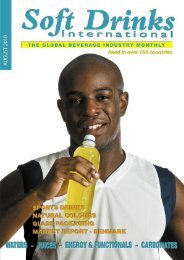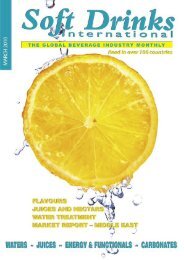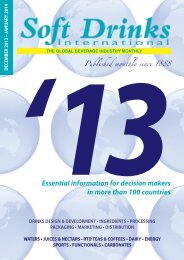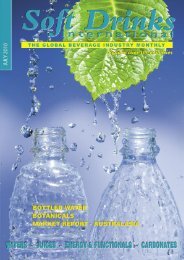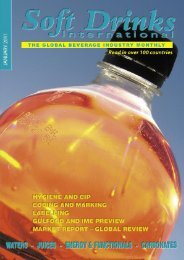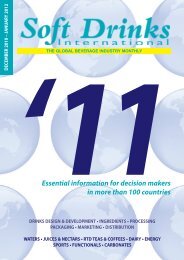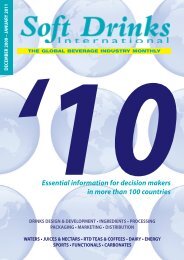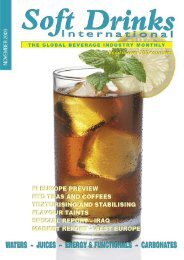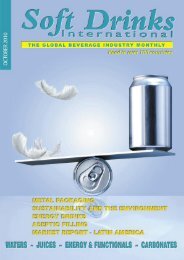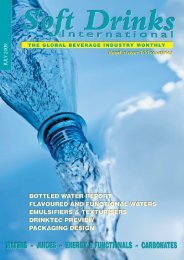Palatinose - Soft Drinks International
Palatinose - Soft Drinks International
Palatinose - Soft Drinks International
You also want an ePaper? Increase the reach of your titles
YUMPU automatically turns print PDFs into web optimized ePapers that Google loves.
36 MArKET AnALYSIS<br />
<strong>Soft</strong> <strong>Drinks</strong> <strong>International</strong> – February 2011<br />
PET wins again<br />
in 2010<br />
There has been<br />
little change to<br />
the long term<br />
trend, reports<br />
richard Corbett.<br />
Evolution of cartons, cans, glass and PET in the last decade.<br />
While in January, we analysed the performance<br />
of the global soft drinks market, this<br />
month attention is turned to what these soft<br />
drinks are packaged in, focusing on the big four<br />
formats: glass, PET, cartons and cans. According<br />
to Canadean’s Wisdom database, in 2010, 86% of<br />
the global soft drinks output were packaged in<br />
one of these pack types. A month into 2011, we<br />
can already use the database to assess the latest<br />
state of play in the global packaging mix for soft<br />
drinks.<br />
Glass<br />
Glass bottles have played a pivotal role in the<br />
development of the soft drinks industry and it<br />
was this type of packaging that enabled the first<br />
soft drinks to reach their audience. These were<br />
the European natural mineral springs that many<br />
believed had medicinal properties. The glass bottle<br />
meant that consumers did not have to travel to<br />
the springs but could enjoy the benefits from the<br />
comfort of their own homes. The real breakthrough<br />
for glass bottles though, which really<br />
allowed soft drinks operators to reach out to the<br />
mainstream, came in 1910 with the invention of<br />
the first automatic bottle blowing machine –<br />
these machines could churn out more than<br />
50,000 bottles a day.<br />
Today glass share of the global soft drinks market<br />
has shrunk considerably. At the turn of the<br />
century 16% of all soft drinks were packed in<br />
glass; today that has halved to 8%. In these difficult<br />
times of economic insecurity, glass has been<br />
the format that has had the most to lose due to its<br />
association with the struggling Horeca channel<br />
and the depressed premium end of the soft drinks<br />
market.<br />
Before we pen the obituary of the glass bottle,<br />
we should however take into account that consumers<br />
in many if not most parts of the world<br />
Source: Canadean<br />
still associate soft drinks in a glass bottle with<br />
quality. There is undoubtedly a perception that<br />
soft drinks taste better from glass and that is why,<br />
when you next treat yourself to a night out; the<br />
restaurant or bar will more than likely be serving<br />
your soft drink in a glass bottle; this justifies the<br />
price premium. Glass remains iconic. Canadean<br />
expect glass volumes to have registered the smallest<br />
of rises in 2010.<br />
PET<br />
Glass has, howeve,r been squeezed out of the<br />
mainstream by PET. This process began just over<br />
30 years ago when the chemist Nathaniel Wyeth<br />
patented the first PET bottle. PET was easier to<br />
handle for retailers, did not break, could be<br />
resealed and was light for the on-the-move consumer.<br />
Not surprisingly, PET was more suitable;<br />
it was instrumental in facilitating the still water<br />
boom that has driven the soft drinks market for a<br />
decade and more.<br />
Advances in PET technologies continue; PET<br />
bottles become lighter by the day, reducing costs<br />
at a time of high oil prices. In the juice, nectars,<br />
still drinks and iced tea categories, shelf life and<br />
other issues have been addressed with the right<br />
barriers, oxygen scavengers and UV blockers<br />
increasing PET’s presence in these soft drinks<br />
categories. It is perhaps no surprise that since<br />
2000 as glass’s influence has dwindled, PET’s has<br />
jumped from 45% of global soft drinks to as much<br />
as 61%. In terms of volume, PET use increased by<br />
4% in 2010 according to the latest Canadean estimates.<br />
Carton<br />
Advances in PET development have obviously<br />
made the beverage carton vulnerable in its juice,<br />
nectars and still drinks heartlands, but the carton<br />
is holding up well. Cartons make up 6% of total<br />
soft drinks volumes; but in non-carbonated soft<br />
drinks this rises to 12%. Of course carton use in<br />
the still water segment is limited to a few markets<br />
and is otherwise niche, so if we just assess juice,<br />
nectars, still drinks and iced teas, which make up<br />
95% of carton volume, then the share increases to<br />
more than a quarter. The impact of PET has how




